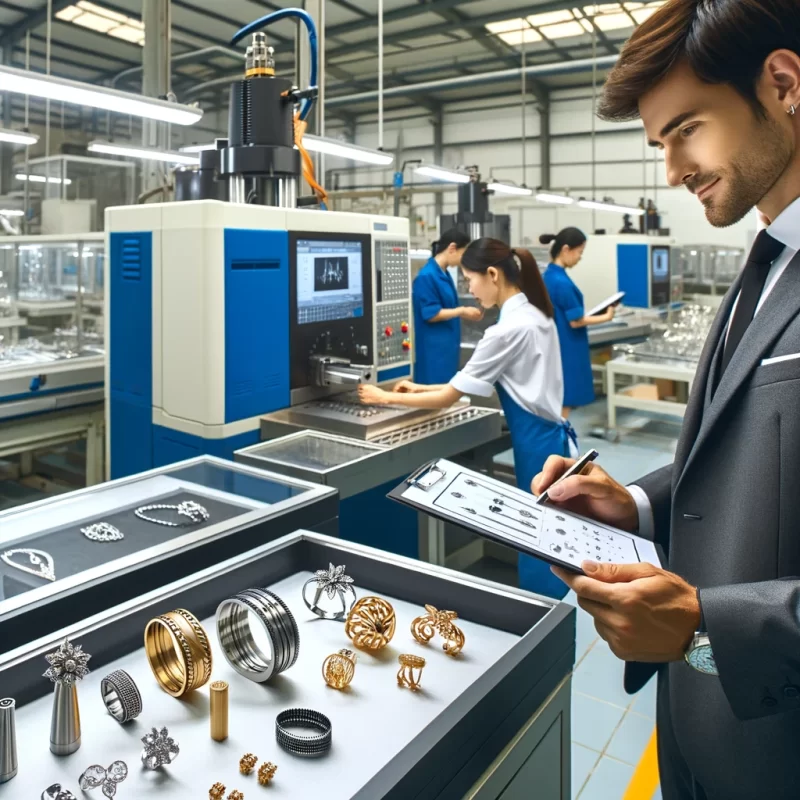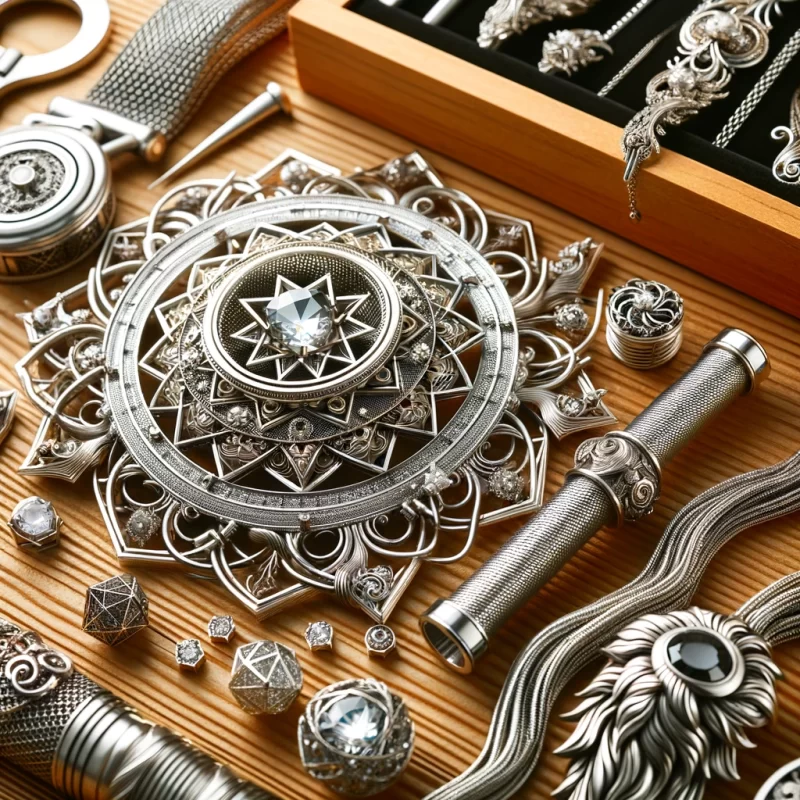
Table of Contents
In the bustling world of fashion and accessories, stainless steel jewelry stands out for its durability, affordability, and sleek aesthetics. But what truly sets apart high-quality stainless steel jewelry? It all boils down to the meticulous details of the production process. From selecting the right materials to the final polishing, every step influences the quality of the final product. Let’s dive into the nuances of this process and uncover how each stage ensures the jewelry you choose is not just beautiful but built to last.
Material Selection: The Foundation of Quality
Stainless steel, known for its resistance to corrosion and rust, is an alloy containing iron, carbon, and chromium. The choice of grade, such as 316L or 304, plays a pivotal role. The 316L grade, often used in medical applications, is particularly renowned for its hypoallergenic properties and higher resistance to pitting and corrosion, making it ideal for jewelry that withstands the test of time and skin sensitivities.
Molding and Casting: Shaping the Vision
The transformation of raw stainless steel into intricate jewelry pieces starts with precise molding and casting processes. Techniques such as die casting and investment casting are commonly employed. Die casting involves forcing molten steel into molds under high pressure, ideal for the mass production of detailed designs. Investment casting, on the other hand, allows for even higher detail and is preferable for complex shapes. This step is crucial as it sets the initial quality and detail of the jewelry piece.
Cutting and Welding: Precision in Detail
After casting, pieces often require cutting and welding to refine shapes and add intricate details. Advanced laser cutting technologies offer unparalleled precision, minimizing material waste and ensuring clean cuts without damaging the integrity of the steel. Welding techniques must be carefully chosen to avoid altering the metal’s properties, with laser welding being the preferred method for its accuracy and clean finish.
Polishing and Finishing: The Art of Perfection
Polishing is perhaps one of the most transformative steps in the production of stainless steel jewelry. It not only enhances the piece’s appearance but also affects its wearability. Mechanical polishing can achieve a mirror-like finish, while chemical processes can increase corrosion resistance. The choice of finish, whether brushed, matte, or shiny, significantly impacts the aesthetic appeal and market value of the jewelry.
Quality Control: The Final Checkpoint
Quality control is integral, ensuring every piece meets stringent standards before hitting the market. This involves visual inspections, stress tests, and sometimes chemical composition analysis. Each piece must be inspected for defects, alignment, and proper finish to guarantee that the jewelry is not only visually appealing but durable and safe for consumer use.
Conclusion
Understanding the production process of stainless steel jewelry highlights the complexity and precision required to produce high-quality pieces. From the careful selection of materials to the final touches in polishing and quality control, every step matters. As consumers or retailers, recognizing these factors helps in making informed choices about the jewelry we wear or sell, ensuring satisfaction and longevity in every piece.
Enhancing Durability Through Heat Treatment
One significant aspect that further influences the quality of stainless steel jewelry is heat treatment. This process involves heating the steel to a high temperature and then cooling it rapidly. Heat treatment can increase the hardness and strength of the metal, making it more durable against scratches and dents. This is especially important for items like rings and bracelets, which are prone to everyday wear and tear.
Electropolishing: Achieving Superior Smoothness and Shine
Electropolishing is another critical step that can enhance the aesthetics and longevity of stainless steel jewelry. This electrochemical process smooths and streamlines the metal surface at a microscopic level, removing imperfections and creating a uniform luster. This not only improves the visual appeal of the jewelry but also enhances its resistance to corrosion, as smoother surfaces are less likely to trap harmful substances that could lead to oxidation and degradation.
Engraving and Detailing: Adding a Personal Touch
Advanced engraving techniques allow for adding personalized details to stainless steel jewelry, making each piece unique. Laser engraving, for instance, offers precision and flexibility to create intricate and customized patterns or inscriptions without affecting the structural integrity of the metal. This personalization is a significant selling point in the market, appealing to customers looking for bespoke or meaningful jewelry.
Incorporating Technology in Design and Prototyping
The use of CAD (Computer-Aided Design) software in the jewelry-making process is a game-changer. It allows designers to create detailed 3D models of jewelry pieces before they are physically produced. This technology not only streamlines the design process but also ensures that the finished product matches the initial vision precisely. Moreover, it enables quick adjustments and iterations, reducing the time and cost associated with traditional prototyping methods.
Sustainable Practices in Stainless Steel Jewelry Manufacturing
Sustainability is becoming increasingly important in jewelry manufacturing. Stainless steel is already known for being recyclable, but manufacturers can further minimize environmental impact by using recycled materials and reducing waste during production. Implementing eco-friendly practices not only appeals to environmentally conscious consumers but also aligns with global efforts to reduce the industry’s carbon footprint.
Conclusion
Delving deeper into the production process of stainless steel jewelry reveals a complex interplay of art and science. Each phase, from material selection to final quality control, is crucial in shaping the quality, durability, and aesthetic appeal of the jewelry. Understanding these processes helps stakeholders in the industry—from designers to consumers—appreciate the value and craftsmanship behind every piece of stainless steel jewelry.
Supply Chain and Vendor Management in Stainless Steel Jewelry Production
An often overlooked yet critical aspect of stainless steel jewelry production is the management of the supply chain and vendor relationships. Effective supply chain management ensures that high-quality raw materials are available when needed, and that production schedules are met without delays. This involves careful selection of suppliers for stainless steel and other materials like precious stones or plating chemicals. Establishing strong, reliable relationships with these vendors can lead to more favorable pricing, priority service, and access to higher-quality materials.
Advanced Quality Assurance Techniques
In the realm of stainless steel jewelry, advanced quality assurance (QA) techniques are pivotal. Employing methods such as X-ray fluorescence (XRF) analyzers allows manufacturers to verify the composition and quality of the metal used. This technology helps in detecting any prohibited elements that could weaken the alloy or cause allergic reactions. Additionally, implementing statistical process control (SPC) techniques can monitor production processes in real-time, identifying any deviations from the norm immediately before they affect the batch’s overall quality.
The Impact of Finishing Techniques on Product Lifespan
Finishing techniques not only enhance the appearance of stainless steel jewelry but also its lifespan and wearability. Techniques such as ion plating provide a durable and attractive finish that can withstand corrosion and maintain its shine for years. This method involves adding a layer of titanium nitride to the stainless steel, which can be gold-toned to mimic the look of gold jewelry at a fraction of the cost. Such finishes are crucial for ensuring the jewelry remains appealing and durable even with everyday wear.
Challenges and Solutions in Mass Production
Mass-producing stainless steel jewelry presents unique challenges, including maintaining consistency in design and quality across thousands of pieces. Automation plays a crucial role in addressing these challenges. Robotics and assembly lines designed specifically for jewelry production can ensure that each piece is made to exact specifications with minimal human error. Furthermore, automating the inspection process with vision systems can speed up quality checks and reduce the likelihood of defective products reaching the market.
The Role of Consumer Feedback in Continuous Improvement
In the competitive jewelry market, consumer feedback is invaluable. It provides direct insights into what aspects of the product resonate with customers and what needs improvement. For instance, if a particular clasp design receives consistent criticism for being too difficult to operate, manufacturers can quickly redesign it in subsequent production cycles. Incorporating this feedback loop into the production process ensures the product continuously evolves to meet consumer demands and preferences.
Conclusion
Exploring the depths of the production process for stainless steel jewelry uncovers a dynamic interplay of technology, craftsmanship, and strategic management. Each element from the supply chain to consumer feedback plays a vital role in shaping the final product’s quality and appeal. Understanding and optimizing these factors are crucial for any manufacturer aiming to stand out in the bustling market of jewelry.
Technological Innovations in Stainless Steel Jewelry Manufacturing
The world of stainless steel jewelry manufacturing is continuously evolving, with new technologies playing a pivotal role in shaping industry standards and capabilities. One such breakthrough is the adoption of 3D printing technology, which allows for rapid prototyping and complex, detailed designs that were previously impossible to achieve with traditional methods. This technology not only speeds up the design process but also reduces waste, as it uses only the necessary amount of material to build each piece layer by layer.
Integration of Artificial Intelligence in Design and Production
Artificial Intelligence (AI) is beginning to make its mark in the jewelry industry, particularly in areas like customer personalization and production optimization. AI algorithms can analyze customer preferences and market trends to suggest customized jewelry designs that are more likely to appeal to specific demographics. In production, AI can optimize the use of materials and streamline production schedules, reducing costs and improving efficiency.
The Growing Importance of E-commerce for Stainless Steel Jewelry
The rise of e-commerce has significantly impacted the way stainless steel jewelry is marketed and sold. Manufacturers and designers are now leveraging online platforms to reach a broader audience. High-quality, detailed images and videos can showcase the unique properties of stainless steel jewelry, such as its luster and durability, to online buyers. Moreover, integrating augmented reality (AR) on these platforms allows customers to virtually try on jewelry before making a purchase, enhancing customer satisfaction and reducing return rates.
Ethical Manufacturing and Corporate Responsibility
As consumer awareness of ethical practices increases, stainless steel jewelry manufacturers are under more scrutiny to uphold ethical manufacturing standards. This includes ensuring that the working conditions in factories are safe and fair for all employees and that the production processes are environmentally friendly. Many companies are adopting Corporate Social Responsibility (CSR) policies that commit to sustainable practices such as recycling and using ethically sourced materials, which not only helps protect the environment but also enhances brand reputation.
Future Trends: Smart Jewelry and Wearable Technology
Looking to the future, stainless steel is poised to be a key player in the integration of jewelry with wearable technology. Its durability and hypoallergenic properties make it an ideal material for smart jewelry that can track health metrics or offer connectivity features. Designers are exploring ways to embed technology seamlessly into attractive, functional pieces that meet the fashion and health needs of modern consumers.
Conclusion
The stainless steel jewelry manufacturing industry is at an exciting crossroads, with technology and innovation driving significant changes in how jewelry is designed, produced, and sold. Embracing these advancements can help manufacturers stay competitive in a rapidly changing market, ensuring they meet the evolving needs and expectations of their customers. By focusing on technology, ethical practices, and consumer engagement through e-commerce, stainless steel jewelry manufacturers can look forward to a bright and successful future.
Adapting to Global Markets: Localization Strategies in Stainless Steel Jewelry
As stainless steel jewelry continues to gain popularity worldwide, manufacturers must consider localization strategies to cater to diverse global markets. This involves adapting designs, marketing materials, and even the production processes to meet the cultural preferences and legal requirements of different countries. For instance, the popularity of certain symbols or the preference for specific jewelry sizes can vary greatly between regions like Asia, Europe, and North America. Understanding these nuances and incorporating them into product offerings can significantly enhance market penetration and customer satisfaction.
Enhancing Customer Engagement Through Social Media
In the digital age, social media platforms have become invaluable tools for stainless steel jewelry manufacturers to engage with customers directly. Platforms like Instagram, Pinterest, and Facebook allow manufacturers to showcase their products, share behind-the-scenes content, and even gather customer feedback in real time. Engaging content that tells the story of the brand and the craftsmanship involved can create emotional connections with customers, fostering brand loyalty and encouraging word-of-mouth promotion.
Overcoming Challenges in Material Sourcing
Material sourcing can present significant challenges, especially in times of global supply chain disruptions. Stainless steel jewelry manufacturers must navigate these challenges by diversifying their supply sources and investing in supply chain resilience. This might include developing relationships with multiple suppliers or investing in technology to improve supply chain visibility and responsiveness. Such strategies can help manufacturers avoid production delays and maintain steady supply to their customers, regardless of external disruptions.
Investing in Training and Development
To ensure that the craftsmanship remains high and that the staff can handle advanced production technologies, continuous training and development are crucial. Offering regular workshops and training sessions not only helps improve the skill level of the workforce but also boosts morale and employee retention. Manufacturers who invest in their employees can expect higher productivity, reduced error rates, and increased innovation in their production processes.
Conclusion
The stainless steel jewelry industry is dynamic and requires manufacturers to be flexible, innovative, and responsive to changes in technology, consumer preferences, and global market trends. By adopting advanced technologies, engaging with customers through digital platforms, navigating supply chain challenges wisely, and investing in their workforce, manufacturers can enhance their competitiveness and ensure sustainable growth.



